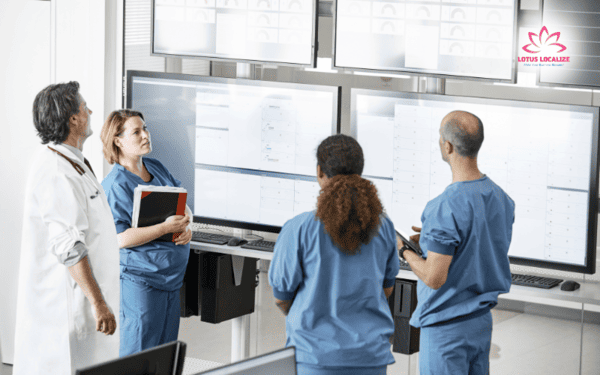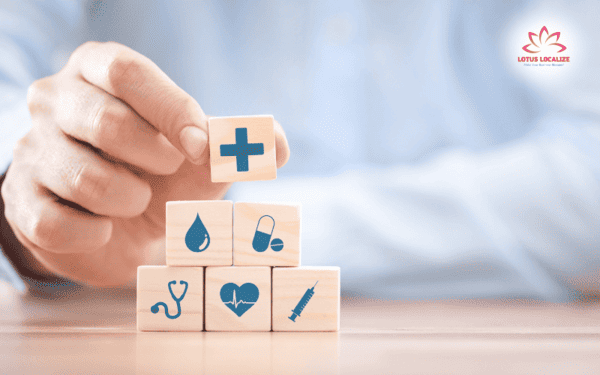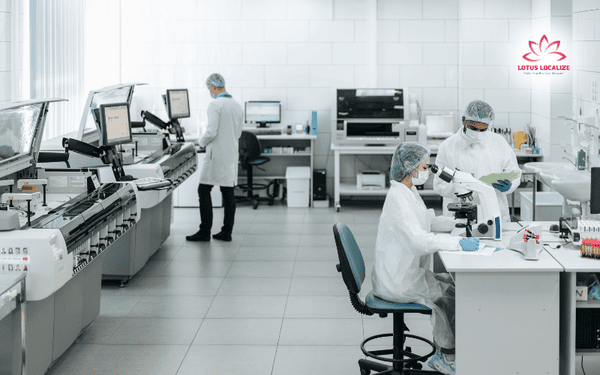
Effective strategies for overcoming language and communication barriers in healthcare
In today’s increasingly multicultural societies, the ability to communicate effectively in healthcare is not just a soft skill—it’s a life-saving necessity. Every day, healthcare providers face situations where they must care for patients who speak different languages or come from vastly different cultural backgrounds. These differences can create significant barriers to understanding, diagnosis, treatment, and overall patient care.
This article explores the impact of language barriers in healthcare, examines the effects of communication barriers in healthcare, and presents practical, proven strategies for overcoming language barriers in healthcare. By addressing these critical issues, healthcare systems can ensure safety, trust, and equality for all patients.
The impact of language barriers in healthcare
Language barriers occur when patients and healthcare providers do not share a common language or have varying levels of language proficiency. The consequences of such barriers extend far beyond simple misunderstandings.
Misdiagnosis and medical errors
One of the most severe consequences of language barriers is the increased risk of misdiagnosis. When patients cannot accurately describe their symptoms, and providers cannot explain diagnoses or treatment plans clearly, the likelihood of errors skyrockets. For instance, a patient might misinterpret dosage instructions or fail to understand the purpose of a prescribed medication.
Limited access to care
Patients with limited proficiency in the dominant language often feel discouraged from seeking medical attention due to fear of miscommunication. This can lead to delayed diagnoses, progression of preventable illnesses, and overall poorer health outcomes.

Informed consent challenges
Informed consent is a legal and ethical cornerstone of healthcare. However, patients who do not fully understand the procedures, risks, or alternatives due to language issues may give consent without truly comprehending what is involved. This undermines their autonomy and can expose healthcare institutions to legal liability.
Increased healthcare costs
Poor communication often leads to repeated consultations, unnecessary diagnostic testing, and hospital readmissions. These outcomes not only compromise patient health but also inflate healthcare costs for both providers and systems.
Strained provider–patient relationships
Trust is fundamental in healthcare. Language barriers can prevent the development of rapport and emotional connection, making patients feel alienated and less likely to follow through with treatment recommendations.
Ultimately, the effects of language barriers in healthcare ripple through every stage of the patient journey—from diagnosis to treatment to recovery. These barriers not only compromise patient safety and well-being but also strain healthcare systems and professionals. Addressing them is not merely a matter of convenience—it is a matter of equity, quality, and ethical responsibility. By recognizing the depth of these challenges, healthcare institutions can begin to implement effective, patient-centered solutions that bridge the communication gap and ensure better outcomes for all.
Read more: Laboratory report translation: Ensuring accuracy and clarity in scientific communication
The effects of communication barriers in healthcare
While language barriers are a major concern, they are only one aspect of a larger issue: communication barriers. These encompass a wide range of factors including cultural misunderstandings, non-verbal cues, technical jargon, and emotional disconnects.
Compromised patient safety
When communication is unclear or inconsistent, crucial information can be lost. Misinterpretation of symptoms, allergies, or previous conditions may lead to incorrect treatments and adverse reactions. Patient safety becomes a gamble when understanding is not mutual.
Reduced patient satisfaction
Patients who feel confused, dismissed, or ignored often report lower satisfaction with their care. This can lead to negative reviews, poor community reputation, and reduced patient retention for healthcare institutions.

Emotional distress and isolation
Patients facing communication barriers may experience anxiety, fear, and frustration. These emotional responses are intensified in vulnerable settings such as emergency rooms or during serious diagnoses. Feeling unheard can worsen the psychological toll of illness.
Staff burnout and miscommunication among teams
Healthcare is a collaborative effort. Miscommunication among multilingual staff or between departments can lead to errors in patient records, duplication of efforts, and general inefficiency. It also increases stress levels for providers who must constantly clarify or correct information.
Disruption in continuity of care
Follow-up care, medication adherence, and long-term treatment plans depend on clear communication. Patients who do not understand discharge instructions or future appointments are more likely to miss critical steps in their recovery, which ultimately hampers continuity of care.
In essence, communication barriers go beyond language—they disrupt care at every level. From compromised safety to emotional distress and system inefficiencies, these challenges highlight the urgent need for clearer, more inclusive communication across the healthcare spectrum.
Read more: What is medical localization? Everything you need to know
Strategies for overcoming language barriers in healthcare
To ensure equitable and effective care, healthcare systems must adopt targeted strategies for overcoming language barriers in healthcare. These solutions should be integrated at both systemic and individual levels.
Use of professional medical interpreters
Hiring trained medical interpreters is one of the most effective ways to bridge language gaps. These professionals are skilled not only in language but also in medical terminology and ethical considerations such as confidentiality.
- On-site interpreters: Ideal for complex or sensitive consultations.
- Remote interpreting (phone or video): Useful for urgent care and areas lacking multilingual staff.
Avoid relying on family members or untrained staff for interpretation, as this can lead to miscommunication and breaches of privacy.
Translation of medical documents and educational materials
All written materials, including consent forms, discharge instructions, and educational brochures, should be available in multiple languages relevant to the local population. Quality translation ensures that patients can make informed decisions about their health.
Multilingual signage, patient portals, and voice-guided systems also contribute to a more inclusive environment.

Staff training in cultural competence and communication
Communication goes beyond words. Healthcare providers must be trained in cultural sensitivity, body language, and active listening. Workshops on cultural norms and effective communication techniques can help bridge the understanding gap between providers and patients from diverse backgrounds.
Additionally, using plain language and minimizing medical jargon can improve comprehension even for native speakers.
Leveraging technology and AI tools
Technology is increasingly playing a role in overcoming language and communication barriers:
- Translation apps and devices: Tools like Google Translate or dedicated medical translation apps can help in real-time conversations (though with caution and backup verification).
- Multilingual electronic health records (EHRs): Systems that allow for documentation in multiple languages support consistency and reduce errors.
AI-driven chatbots and virtual assistants with multilingual capabilities are also emerging as accessible tools for both patients and providers.
Community engagement and outreach
Building relationships with multicultural communities outside the clinical setting fosters trust and understanding. Hiring bilingual healthcare staff or community health workers who speak the languages of underserved populations helps bridge cultural divides.
Additionally, hosting health education workshops in multiple languages and participating in community events can increase awareness and access to care.
By implementing these strategies in a coordinated and thoughtful manner, healthcare systems can move toward more equitable, patient-centered care. Breaking down language barriers not only enhances clinical outcomes but also strengthens trust, communication, and long-term engagement between providers and the diverse communities they serve.
Long-term benefits of addressing language and communication barriers
Investing in strategies to eliminate language and communication barriers leads to:
- Improved patient outcomes: Better understanding leads to better compliance and recovery.
- Enhanced patient trust and loyalty: Satisfied patients are more likely to return and recommend services.

- Cost savings: Fewer errors, less duplication, and reduced readmission rates.
- Legal protection: Proper communication safeguards against malpractice and consent issues.
- Inclusive reputation: Organizations that prioritize inclusive care stand out as leaders in equity and accessibility.
In a world where borders are becoming more fluid and healthcare is more global than ever, the ability to communicate across languages and cultures is not optional—it’s essential. The impact of language barriers in healthcare and the broader effects of communication barriers in healthcare can no longer be ignored.
By implementing thoughtful, evidence-based strategies for overcoming language barriers in healthcare, medical institutions can improve health equity, reduce costs, and most importantly, save lives. Now is the time for healthcare systems to break down these walls—and build a future of communication without borders.
Lotus Localize offers professional translation services for various specialized industries: life sciences translation, technology translation, manufacturing translation, e-learning translation, legal translation, media translation, marketing translation… ensuring your message resonates—whether in writing or speech. Let us help you bridge linguistic gaps and connect with audiences worldwide.
Contact us today at our hotline or Whatsapp: + 84 866 224 968 or visit the websites: dichthuathoasen.com/en/. Let Lotus Localize accompany you in bringing products, people, and culture to the global stage, and together, we’ll create miracles!
QUALITY PROMISE
At Lotus Localize, we are dedicated to delivering high-quality services and ensuring the utmost satisfaction in every client project. Our team of translators and staff consistently exert effort and adhere rigorously to quality management procedures. This commitment guarantees that each project progresses seamlessly, meets deadlines, and exceeds our clients' expectations.












